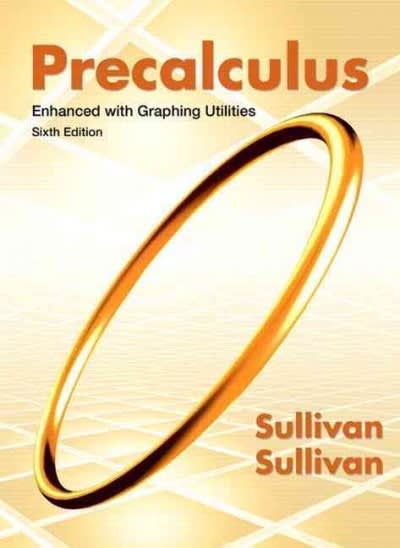Question
Can someone help me with the following questions? Thank you! 1) A government sample survey plans to measure the LDL (bad) cholesterol level of a
Can someone help me with the following questions? Thank you!
1) A government sample survey plans to measure the LDL (bad) cholesterol level of a SRS of men aged 20 to 34. Suppose that in fact the LDL cholesterol level of all men aged 20 to 34 follows the Normal distribution with mean = 115 milligrams per deciliter (mg/dL) and standard deviation = 15 mg/dL. Using the sampling distribution of sample mean, what is the probability that the sample mean takes a value between 114 and 116 mg/dL? This is the probability that the sample mean estimates within 1 mg/dL. (Round your answer to three decimal places.)
- Choose a SRS of 1000 men from this population. This changes the sampling distribution of sample mean. Now what is the probability that the sample mean falls within 1 mg/dL of ? The larger sample is much more likely to give an accurate estimate of . (Round your answer to three decimal places.)
2) The gypsy moth is a serious threat to oak and aspen trees. A state agriculture department places traps throughout the state to detect the moths. Traps are checked periodically, and the distribution of moth counts is discrete and strongly skewed. Most traps have no moths but some traps have several moths. The mean number of moths per trap is only 0.9 with standard deviation 1.3.
- What are the mean and standard deviation of the average number of moths sample mean in 60 traps? (Round your mean to one decimal place and your standard deviation to three decimal places.) mean=? standard deviation=?
- Use the result of the central limit theorem (with the previous parameter values) to find the probability that the average number of moths in 60 traps is greater than 1. (Round your answer to three decimal places.)
3) A class survey in a large class for first-year college students asked, "About how many hours do you study during a typical week?" The mean response of the 413 students was sample mean= 13.5 hours and sample standard deviation s = 7.5 hours.
- Use the survey result to give a 99% confidence interval for the mean study time of all first-year students (using t, because we do not know \sigma, we only know s). (Round your answers to one decimal place.)
4) A poll in November 2013 found that 58% of the people in the sample said they want to lose weight. After doing analysis, they announced, "For results based on the total sample of national adults, one can say with 95% confidence that the maximum margin of sampling error is 6 percentage points."
- What is the 95% confidence interval for the percent of all adults who want to lose weight? (Enter your answers as whole numbers.)
5) Consider the following questions about critical values. Find the Normal critical value z* for confidence level C = 80% (Round to two decimal places.) z* =
- How much area is in each tail of the Normal distribution when finding this z* (enter a decimal, not percentage).
- Find the t critical value t* for confidence level C = 85% assuming we take a sample of 50. t* =
6) The National Institute of Standards and Technology (NIST) supplies "standard materials" whose physical properties are supposed to be known. For example, you can buy from NIST an iron rod whose electrical conductivity is supposed to be 10.1 at 293 kelvin. (The units for conductivity are microsiemens per centimeter. Distilled water has conductivity 0.5.) Of course, no measurement is exactly correct. NIST knows the variability of its measurements very well, so it is quite realistic to assume that the population of all measurements of the same rod has the Normal distribution with mean equal to the true conductivity and standard deviation = 0.2. Here are six measurements on the same standard iron rod, which is supposed to have conductivity 10.1.
10.07 9.88 10.03 10.16 10.21 10.11
- NIST wants to give the buyer of this iron rod a 90% confidence interval for its true conductivity. What is this interval? (Round your answers to two decimal places.)
7) We have survey data on the body mass index (BMI) of 656 young women. The mean BMI in the sample was sample mean=26 with sample standard deviation s=6.
Find the margin of error for 95% confidence based on the sample (using a t* value. Round your answers to three decimal places). n = 656 m=?
- Now assume the sample had either 396 young women and 1613 young women instead. n = 396 m =?
- n = 1613 m =?
8) A fast-food company advertises that the pre-cooked weight for its half-pound burgers is, on average, 0.5 pounds. Jayda is in charge of a quality control test that involves weighing a sample of burgers to see if if the sample mean weight is significantly different than 0.5 pounds. She takes a random sample of 30 burgers and finds a mean weight of 0.54 pounds and a sample standard deviation of 0.05 pounds.
Jayda wants to use these sample data to conduct a t test on the mean. Assume that all conditions for inference have been met.
What is the test statistic for this testing procedure? (Round to two decimal places)
- t =?
Step by Step Solution
There are 3 Steps involved in it
Step: 1

Get Instant Access to Expert-Tailored Solutions
See step-by-step solutions with expert insights and AI powered tools for academic success
Step: 2

Step: 3

Ace Your Homework with AI
Get the answers you need in no time with our AI-driven, step-by-step assistance
Get Started


